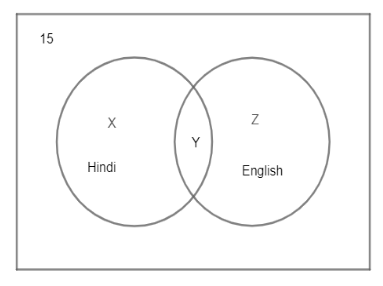Answer
401.1k+ views
Hint: Here, we will draw the Venn diagram for the given problem and then consider the number of elements in each of the regions obtained as x, y and z. The union set represents the total number of students in the group. The region of the union set which is outside the circles representing the number of students who can read Hindi or English represent those students who can read neither Hindi nor English.Therefore, we will calculate the value of x, y and z using the given conditions.
Complete step-by-step answer:
The Venn diagram for this problem can be drawn as:

Here, we can observe that:
Total number of students who can read Hindi = x+y
Total number of students who can read English = y+z
Total number of students who can read both Hindi and English = y
Therefore, from the given data, we can write:
$ x+y=7..........\left( 1 \right) $
$ y+z=5..........\left( 2 \right) $
Now, it is also given that 6 students can read neither English nor Hndi. So:
( Total number of students ) – ( x+y+z) = 6
$ \Rightarrow 15-\left( x+y+z \right)=6 $
$ \Rightarrow x+y+z=9.......\left( 3 \right) $
Now, we will find the values of y using equations (1), (2) and (3).
On subtracting equation (2) from equation (3), we get:
$ \begin{align}
& \left( x+y+z \right)-\left( y+z \right)=9-5 \\
& \Rightarrow x+y+z-y-z=4 \\
& \Rightarrow x=4 \\
\end{align} $
So, the value of x comes out to be equal to 4.
On putting x = 4 in equation (1), we get:
$ \begin{align}
& 4+y=7 \\
& \Rightarrow y=7-4=3 \\
\end{align} $
So, the value of y comes out to be equal to 3 which means that 3 students can read both English and Hindi.
Hence, option (c) is the correct answer.
Note: Students should note here that the elements which are common to two sets come under their intersection. So, here the intersection of the two sets gives us the number of students who fall in both the categories. It should be kept in mind that the region of the union set outside the circles represent the number of students who cannot read any of the languages. So, we write that 15 – (x+y+z) is equal to 6. Some students directly write the answer by taking the values from the question as 15 - 7 - 5 = 3. This is not the right way to solve the question. Steps should be mentioned in detail to get full marks in the exams. It will also show the knowledge the student has in this topic.
Complete step-by-step answer:
The Venn diagram for this problem can be drawn as:

Here, we can observe that:
Total number of students who can read Hindi = x+y
Total number of students who can read English = y+z
Total number of students who can read both Hindi and English = y
Therefore, from the given data, we can write:
$ x+y=7..........\left( 1 \right) $
$ y+z=5..........\left( 2 \right) $
Now, it is also given that 6 students can read neither English nor Hndi. So:
( Total number of students ) – ( x+y+z) = 6
$ \Rightarrow 15-\left( x+y+z \right)=6 $
$ \Rightarrow x+y+z=9.......\left( 3 \right) $
Now, we will find the values of y using equations (1), (2) and (3).
On subtracting equation (2) from equation (3), we get:
$ \begin{align}
& \left( x+y+z \right)-\left( y+z \right)=9-5 \\
& \Rightarrow x+y+z-y-z=4 \\
& \Rightarrow x=4 \\
\end{align} $
So, the value of x comes out to be equal to 4.
On putting x = 4 in equation (1), we get:
$ \begin{align}
& 4+y=7 \\
& \Rightarrow y=7-4=3 \\
\end{align} $
So, the value of y comes out to be equal to 3 which means that 3 students can read both English and Hindi.
Hence, option (c) is the correct answer.
Note: Students should note here that the elements which are common to two sets come under their intersection. So, here the intersection of the two sets gives us the number of students who fall in both the categories. It should be kept in mind that the region of the union set outside the circles represent the number of students who cannot read any of the languages. So, we write that 15 – (x+y+z) is equal to 6. Some students directly write the answer by taking the values from the question as 15 - 7 - 5 = 3. This is not the right way to solve the question. Steps should be mentioned in detail to get full marks in the exams. It will also show the knowledge the student has in this topic.
Recently Updated Pages
The branch of science which deals with nature and natural class 10 physics CBSE

The Equation xxx + 2 is Satisfied when x is Equal to Class 10 Maths

Define absolute refractive index of a medium

Find out what do the algal bloom and redtides sign class 10 biology CBSE

Prove that the function fleft x right xn is continuous class 12 maths CBSE

Find the values of other five trigonometric functions class 10 maths CBSE

Trending doubts
Difference between Prokaryotic cell and Eukaryotic class 11 biology CBSE

Difference Between Plant Cell and Animal Cell

Select the word that is correctly spelled a Twelveth class 10 english CBSE

Fill the blanks with the suitable prepositions 1 The class 9 english CBSE

What is the z value for a 90 95 and 99 percent confidence class 11 maths CBSE

Give 10 examples for herbs , shrubs , climbers , creepers

What organs are located on the left side of your body class 11 biology CBSE

What is BLO What is the full form of BLO class 8 social science CBSE

Change the following sentences into negative and interrogative class 10 english CBSE



